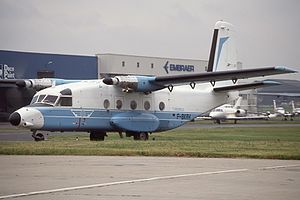Nord 260
| MH.260 Super Broussard Nord 260 | |
|---|---|

| |
| Nord 260A. | |
| Role | Passenger turboprop airliner |
| National origin | France |
| Manufacturer | Avions Max Holste / Nord Aviation |
| First flight | 29 July 1960 |
| Primary user | French Air Force |
| Number built | 9 (1 x MH-260 and 8 x Nord 260) |
| Developed into | Aérospatiale N 262 |
The Nord 260, built in prototype form as the Max Holste MH.260 Super Broussard, ("Super Bushranger"), was a turboprop-powered, uprated version of the piston-engined Max Holste MH.250 Super Broussard, that was further developed into the Aérospatiale N 262.[1][verification needed]
Design and development[]
The MH.260 was designed in partnership with Nord Aviation to carry 23 passengers or 3,445 kg (7,595 lb) of cargo on short fields, as a modern equivalent of the DC-3.[2] [3][verification needed]
The MH.260 was a high-wing, twin-engine turboprop aircraft powered by 731 kW (980 hp) Turbomeca Bastan engines. The fuselage was of all -aluminum construction with fabric covered control surfaces. The landing gear retracted into fuselage-mounted fairings.[4]
The prototype was built at a Nord Aviation facility, so it followed naturally that production aircraft should also be built there.[citation needed] The MH-260 design was taken over by Nord and production was commenced to fill a French government order for ten aircraft under the designation Nord 260. No orders were received from outside the government as the nascent Nord 262 offered better performance. Eight Nord 260s were completed and delivered to a few airlines on lease for short periods before final delivery to the French Air Force at .[citation needed]
Variants[]
- MH.260 Super Broussard
- The sole prototype c/n 001, built for Max-Holste at a Nord Aviation factory.
- Nord MH.260
- Ten production aircraft were ordered by the French government, but only eight were completed. Not released for general service, but delivered to the French Air Force at for use as transports. Several were leased out temporarily pending delivery of the much improved Nord 262.[citation needed]
- Nord MH.260 (Astazou)
- Construction no 03 was re-engined with Turbomeca Astazou turboprops after acquisition by Turbomeca.[citation needed]
- Nord MH.260A
- Probably an alternative designation for the MH.260 (Astazou), the sole example, (regn. F-BKRH), powered by Astazou engines was operated by Turbomeca.
Operators[]
 France
France- French Air Force -
 Norway
Norway- Widerøe - Three aircraft leased pending delivery of Nord 262 aircraft.[5]
Specifications (Nord 260)[]
Data from MH-260 Super Broussard[6]
General characteristics
- Crew: two
- Capacity: 23
- Length: 17.60 m (57 ft 9 in)
- Wingspan: 21.92 m (71 ft 11 in)
- Height: 6.58 m (21 ft 7 in)
- Wing area: 55.0 m2 (592 sq ft) [7]
- Empty weight: 5,600 kg (12,345 lb)
- Gross weight: 9,400 kg (20,723 lb)
- Fuel capacity: 2,000 litres (440 imp gal; 530 US gal)
- Powerplant: 2 × Turbomeca Bastan IV Turboprop, 735 kW (985 hp) each
- Propellers: 3-bladed Ratier-Figeac
Performance
- Cruise speed: 380 km/h (236 mph, 205 kn)
- Stall speed: 90 km/h (56 mph, 49 kn)
- Range: 1,500 km (930 mi, 810 nmi)
- Service ceiling: 8,100 m (26,500 ft)
- Rate of climb: 8.5 m/s (1,670 ft/min)
References[]
- ^ Aviation Week and Space Technology. 77. 1961. Missing or empty
|title=(help) - ^ Peter W. Brooks. The world's airliners. p. 360.
- ^ "Flight International". Vol. 81. Cite magazine requires
|magazine=(help) - ^ Watkins Flying December 1961, pp. 33, 89.
- ^ "Widerøe" (PDF). London: www.plane-spotter.com. Retrieved 25 January 2012.
- ^ Watkins Flying December 1961, p. 90.
- ^ Taylor 1961, pp. 56–57
- Coleman, Herbert J. (20 August 1962). "Aviation Week Pilot Report: Nord Pushes Super Broussard Production". Aviation Week and Space Technology. Vol. 77 no. 8. pp. 104–106.
- Lambert, Mark (13 November 1959). "Super Broussard Breaks Through: Max Holste's Latest on the Ground and in the Air". Flight. Vol. 76 no. 2644. pp. 542–544.
- Lambert, Mark (22 June 1961). "Holste Super Broussard in the air: No. 148 in the series". Flight. Vol. 79 no. 2727. pp. 860–861.
- Taylor, John W. R. (1961). Jane's All the World's Aircraft 1961–62. Sampson Low, Marston & Company, Ltd.
- Watkins, Peter W. (December 1961). "MH-260 Super Broussard". Flying. Vol. 69 no. 6. pp. 33, 89–91.
External links[]
| Wikimedia Commons has media related to Nord 260. |
- 1960s French airliners
- Max Holste aircraft
- Nord aircraft
- High-wing aircraft
- Aircraft first flown in 1960
- Twin-turboprop tractor aircraft